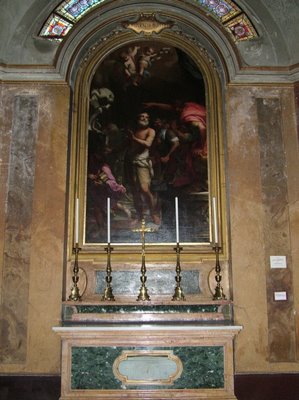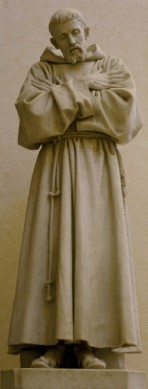
Back in 2000, I had read a story about a priest (however, it was not Saint John Marie Vianney) who had begun praying to a very obscure and unknown Saint. He reasoned that because this Saint was so unknown, she would have more "time" to pray for him and his intentions. And sure enough, intentions he had for his parish were coming to pass through the intercession of this Saint.
A few weeks after I read that story I was in Rome for the Jubilee year and my friend Father Cassian had suggested I visit the basilica of Saints John and Paul (the ones mentioned together in the Roman Canon). While I was there, I was struck by a painting and relics in a side altar of Saint Saturninus of Carthage (as seen above). And having never heard of him before, I thought about that story I had read about the priest who began praying to this obscure Saint. So, I've had a devotion to Saint Saturninus of Carthage ever since. And I was blessed to be able to visit him on my last trip to Rome back in October.

The new (2004) Roman Martyrology has this:
Romæ in cœmetério Trasónis via Salária Nova, sancti Saturníni Carthaginénsis, mártyris, qui, ut sanctus Dámasus papa refert, sub Décio imperatóre pro Christo in pátria in ecúleo impósitus est et Romam extórris missus, ubi, áliis atrócibus torméntis superátis, Gratiánum tyránnum ad fidem convértit et cápite obtruncáto corónam martýrii adéptus est.
My rough translation
At Rome, in the cemetary of Trasonis on the New Via Salaria, Saint Saturninus of Carthage, martyr, who, Pope Saint Damasus relates, that under the Emperor Decius, in his homeland he [St. Saturninus] was placed on the rack for Christ, and sent into exile in Rome, where, having overcome other severe tortures, converted the tyrant Gratianus to the faith, and [St. Saturninus] being beheaded obtained the crown of martyrdom.
An older version of the Roman Martyrology has this:
Romæ, via Salaria, natális sanctórum Mártyrum Saturnini senis, et Sisinii Diáconi, sub Maximiáno Príncipe; quos, diu in cárcere maceratos, jussit Urbis Præfectus in equuleum levári et attrahi nervis, fustibus ac scorpiónibus cædi, deínde eis flammas apponi, et, depositos de equuleo, cápite truncari.- from breviary.net's Roman Maryrology pages
At Rome, on the Salarian Way, the birthday of the holy martyr, Saturninus, an aged man, and the deacon Sisinius, in the time of Emperor Maximian. After a long imprisonment, by order of the prefect of the city they were placed on the rack, stretched with ropes, scourged with rods and whips garnished with metal, then exposed to the flames, taken down from the rack and beheaded.
(Sorry, it's a good site for the old martyrology, but the site is run by sedevacantists).
I'm not sure what happened to St. Saturninus' deacon companion Sisinius in the new Martyrology. I often worry that some parts of legends are automatically thrown out if they can't be proven, rather than keeping them until the can be proven false. I feel that is often the case in the rather snotty comments in the Thurston & Atwater edition of Butler's Lives of the Saints.
A brief article at catholicculture.org had this to say:
St. Saturninus
The Martyrology gives these details: "At Rome on the Via Salaria the death of the holy martyr, the aged Saturninus, and of the deacon Sisinius. Under the emperor Maximianus they suffered long in prison. The prefect of Rome ordered them placed on the rack till their joints were torn loose, then beaten with knotted whips, and burnt with torches; at last removed from the rack, they were beheaded." According to the inscription on his tomb by Pope St. Damasus, Saturninus hailed from Carthage. The Acts of Marcellus say he was condemned as a frail old man to carry sand for the construction of the Baths of Diocletian; but when by his patience and prayer and encouragement he led many to the faith, he was beheaded.
Saint Saturninus was originally buried in the Catacombs, and Pope Saint Damasus wrote a beautiful epitaph on his tomb there:
Epigraph of Pope Saint Damasus for St. Saturninus
Citizen now of Christ, formerly of Carthage,
The moment the sword pierced the Mother's holy breast,
through her blood he changed country, name and lineage,
the birth to the life of the saints made him a Roman citizen.
His faith was wonderful: as his heroic death would later show.
His enemy Gratianus trembled while he tore his holy members;
but though all his venomous rage exploded,
he could not induce you, O Saint, to deny Christ;
indeed through your prayers he even deserved to die a Christian.
This is the will of the suppliant Damasus: venerate this tomb!
[Here it is given to fulfil vows and to pour out chaste prayers,
because it is the tomb of the martyr St Saturninus]
To you, O Martyr Saturninus, I pay my prayerful homage.
source
Here's the collect for his feast (which used to be on the universal calendar before the changes of Vatican II) from the traditional Divine Office:
Orémus.
Deus, qui nos beáti Saturníni Mártyris tui concédis natalício pérfrui: eius nos tríbue méritis adiuvári. Per Dóminum nostrum Iesum Christum, qui tecum vivit et regnat in unitáte Spíritus Sancti Deus, per ómnia saécula sæculórum. Amen.
Let us pray.
O God, Who givest us to rejoice in the feast of Thy blessed Martyr Saturninus: grant that we may be helped by his merits. Through our Lord Jesus Christ Thy Son, Who livest and reignest with Thee in the unity of the Holy Spirit, God, forever and ever. Amen.
I have become devoted to him, and love the fact that in spite of his old age he suffered for Christ, to the point of torture, exile, more torture, and martyrdom. He does show that God chooses the weak to shame the strong.
Sancte Saturníne (et Sancte Sisinie), ora(te) pro nobis.
"To you, O Martyr Saturninus, I pay my prayerful homage" as well.
And to any priests who are saying the extraordinary form of the Mass and can follow the traditional calendar or who say the ordinary form and have a copy of the Roman Martyrology, I invite you to remember him as well.
RS






No comments:
Post a Comment